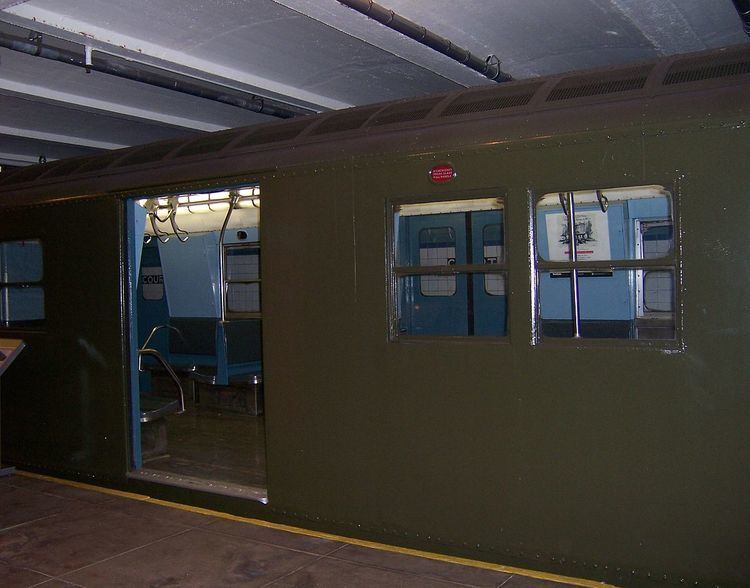Replaced BMT Zephyr Entered service 1955 | Constructed 1954-1955 Number built 200 | |
 | ||
Scrapped 1983 (6400-6499)1987 (6300-6399) | ||
The R16 was a New York City Subway car built by American Car and Foundry Company from 1954 to 1955.
Contents
Description
The R16s were numbered 6300–6499.
When delivered, the R16's quickly became the new standard in car design for the New York City Transit Authority. Structurally and mechanically, they were the larger versions of the R17s and yet basically an improved version of the R10s with same exact dimensions except that the R16's had electrically operated door motors while the R10s had pneumatic door engines. When they were new, the R16's could give the R10 some competition when it came to speed - both cars were mechanically similar with four 100 horsepower motors and a balancing speed of 55 MPH.
The R16s, like the older Arnines, R10s, and R11s, featured three sets of mid-carbody passenger windows on each side. One set contained an illuminated rollsign box in lieu of a second window. This sign box had three readings arranged vertically - the top two being the train's terminals, and the bottom being the route. This window and signbox pattern became standard for later cars until the R40s. The R16 would also be the last car class delivered with cross wise seating until the R44 order in 1972.
There were two versions of the R16: Westinghouse-powered cars (6300-6399) and General Electric-powered cars (6400-6499), the latter of which were delivered earlier. The General Electric-powered cars used forced air to cool the rheostatic resistors used for acceleration and dynamic braking. Unfortunately, the low voltage rotary converter (motor-generator) was used to provide the air and proved to be problematic as the enclosure tended to trap dirt and rain water within, leading to high failure rates. Meanwhile, the Westinghouse-powered cars had resistors mounted in the open for slip stream cooling as had been the traditional means; this setup was found to be more reliable, and was used until the R22 order. In theory, both types of R16s could be run together; however, in practice, this was found to be less than desirable. Later in their service lives, cars of all classes would be segregated by electrical running gear to provide better fleet reliability.
History
The R16s were delivered between 1954-1955 in a kale green paint scheme, and first placed into passenger service on January 10, 1955 on the BMT #15, (now J). Two cars were painted gold for a celebration in 1955.
R16s 6300-6349 were transferred to the A in preparation for the opening of the former Long Island Rail Road's IND Rockaway Line on June 28, 1956, as the Transit Authority wished to use its newest equipment available for the line's inaugural. After the late 1950s, the cars were returned to the BMT Eastern Division and would remain there until the late 1960s and the early 1970s, when they were transferred to various lines throughout the system. During the 1970s, R16s could be found intermixed with other cars and in far away places from their previous running grounds. Photos of R16's in the Bronx or Queens show them both in complete consists as well as with strange bedfellows.
In 1968, many cars were repainted into a bright red scheme. The whole R16 fleet was given the new MTA corporate silver and blue scheme in 1970, and the cars kept the scheme until retirement.
During the early 1970s, the R16s had their door motors replaced with ones similar those used by the R44s. As the replacement door motors were mounted in the walls rather than under the seats; distinctive sloping wall panels (unique to the R16s) appeared.
Retirement
Due to their persistent electrical issues, the GE-powered R16s were planned to be retired early by the R46s in 1977. However, recalls due to cracks found in the R46 trucks (as well as a host of other defects) kept the GE R16s in service until 1983. The more reliable Westinghouse-equipped R16 cars remained in service until the late 1980s, when they were replaced with the R68s. The last R16s ran in May 1987 on the M line.
After retirement, four R16 cars were saved for various purposes, including:
6452 was located at PS 248 (a NYCT training facility) until July 2004, Brooklyn as a training car. It was painted in redbird scheme and wasn't operational. In July 2004, the car was moved to Linden Yard in Brooklyn and was replaced by R110B 3005, which was moved to the facility. 6452 was moved again to they Coney Island Yard in 2005. Finally, in July 2007, the car was moved to the SBK yard for asbestos abatement and sent to the 207 St. Yard for reefing in early 2008.
In popular culture
Various R16s were featured in the 1981 made-for-TV film "We're Fighting Back", including the interior of some R16s. Several of them included 6301, 6302, 6321, 6333, 6355, 6394, 6398, and 6399, signed up as an LL train. Various stations were renamed in the film, but there are various hints, including the fact it was a solid 8-car set of R16's rather than a 10-car set that it was filmed on the BMT Canarsie Line.
A wooden mockup of an R16 was featured in the 1976 remake of King Kong.
In the 1959 film Imitation of Life several trains consisting of R16s can be seen passing outside the studio window in the flea powder ad scene.
